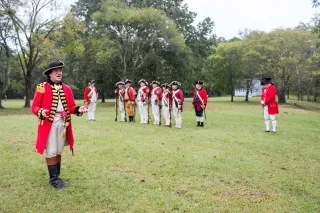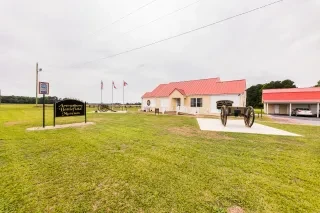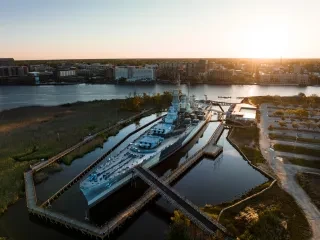
Hero - Interior Page Hero Module
From an early declaration of independence to modern-day Special Forces, eastern North Carolina is rich in military history.
Listicle View

Historic Halifax State Historic Site
On I-95 is the town of Halifax and the Historic Halifax State Historic Site. Halifax was a commercial river port that became a revolutionary hotbed in 1776 when a document called the “Halifax Resolves” became the first official action by an entire colony recommending independence from England. A free 60-minute guided tour includes several historic buildings, a cemetery, jail and the clerk of courts office. Mark your calendars: With the 250th anniversary of the signing coming up in 2026, a celebration for the ages is planned.
Bentonville Battlefield State Historic Site
The largest land engagement in North Carolina and one of the last conflicts of the Civil War was fought at Bentonville Battlefield in March 1865. The hallmark of the visitors center is a fiber-optic map exhibit, which provides instant spatial orientation for visitors to the battlefield. The c. 1855 Harper House is furnished as a Civil War field hospital, and the grounds include battle trenches, a cemetery and history trails with exhibits. Attend special events around the anniversary of the battle, plus summer seasonal living history programs.

Averasboro Battlefield Museum
Historic markers outline the events of the tactical resistance leading up to the Battle of Bentonville. You’ll also see Lebanon, a plantation home used as a Confederate Hospital, and the Chicora Civil War Cemetery where the battle’s casualties are buried.
General William C. Lee Airborne Museum
This is the former house of General Lee, known as the “Father of the American Airborne.” Lee was assigned by President Franklin D. Roosevelt to organize the development of Army airborne units.

Airborne & Special Operations Museum
This 59,000-square-foot museum features life-size dioramas, rare aircraft, artifacts and interactive displays commemorating this special sector of the armed forces from its inception in 1940. Highlights include a large screen movie theater and a 24-seat motion simulator that puts you in the midst of parachute jumps, helicopter gunship attacks and daring missions.
Museum of the Cape Fear
This museum traces the events that shaped the development of southern North Carolina. Highlights include pottery and exhibits about the early settlements of American Indians, the antebellum period, the Civil War and the textile industry. Arsenal Park reveals the history of a federal arsenal.

Battleship North Carolina
Commissioned in 1941, Battleship North Carolina served in every major naval offensive in the Pacific in World War II, earning 15 battle stars. A two-hour self-guided tour includes an orientation exhibit and portions of nine decks, including the crew’s quarters, the bridge, gun turrets, and radio and engine rooms.
Cape Fear Museum
Not to be confused with the Museum of the Cape Fear, the Cape Fear Museum in Wilmington has an extensive Civil War collection featuring the Wilmington waterfront as it was in 1863 and a diorama of the Second Battle of Fort Fisher.

Fort Fisher State Historic Site
Fort Fisher was one of the largest Confederate earthen seacoast fortifications. A key element of the most crucial naval bombardment and amphibious operation of the Civil War, the fort protected blockade runners carrying supplies to Wilmington before its fall in January 1865.
Moores Creek National Battlefield
This 87-acre site was the scene of a brief but decisive Revolutionary War battle Feb. 27, 1776. Victory by the colonists prevented the Loyalists from controlling North Carolina and helped block a British campaign to conquer the Southern Colonies.



